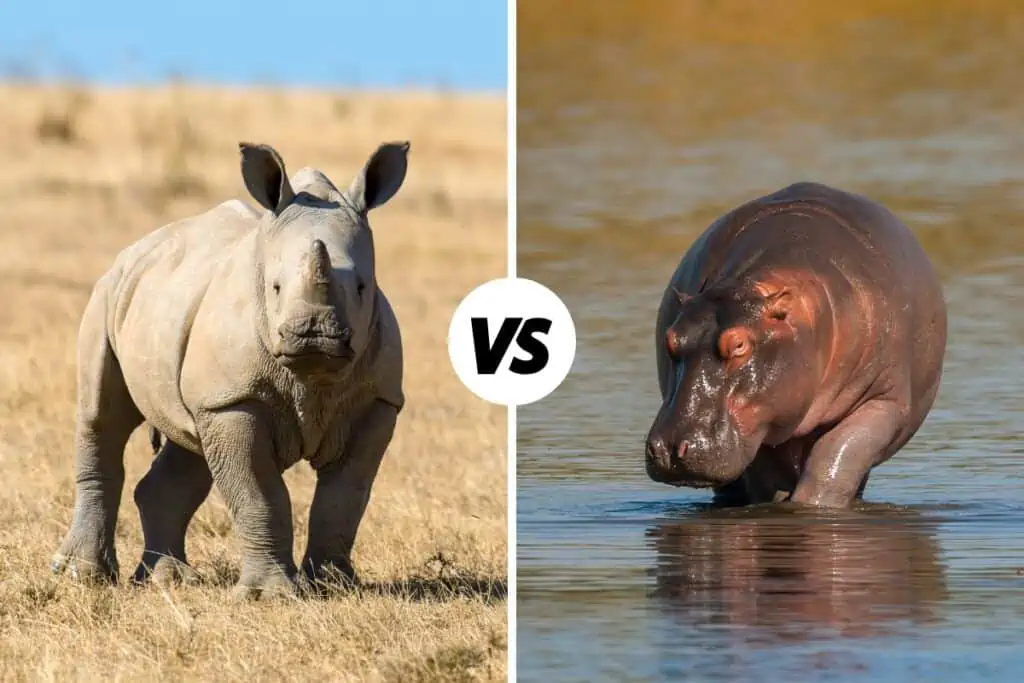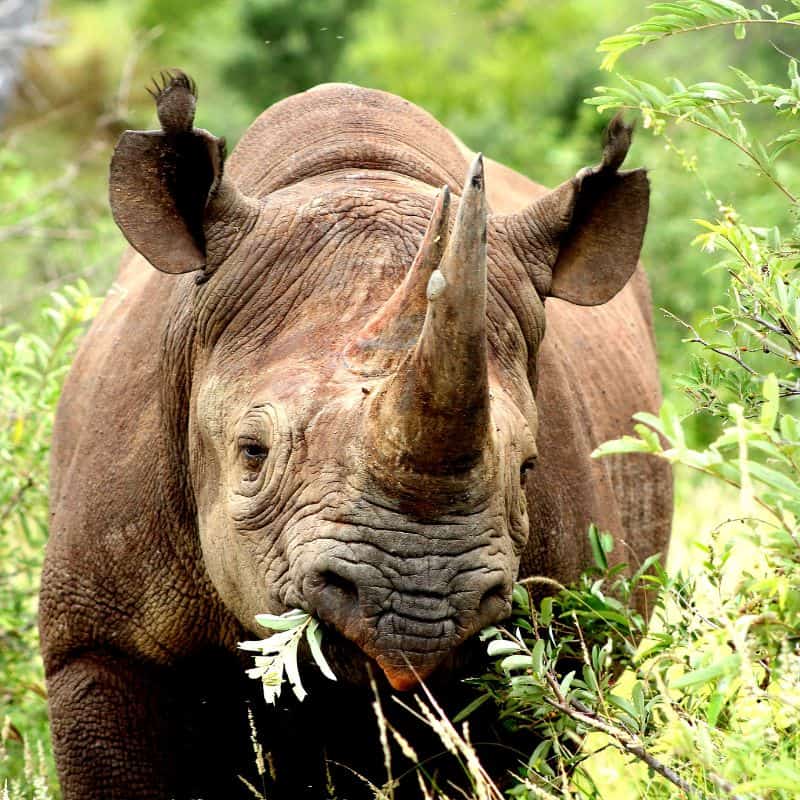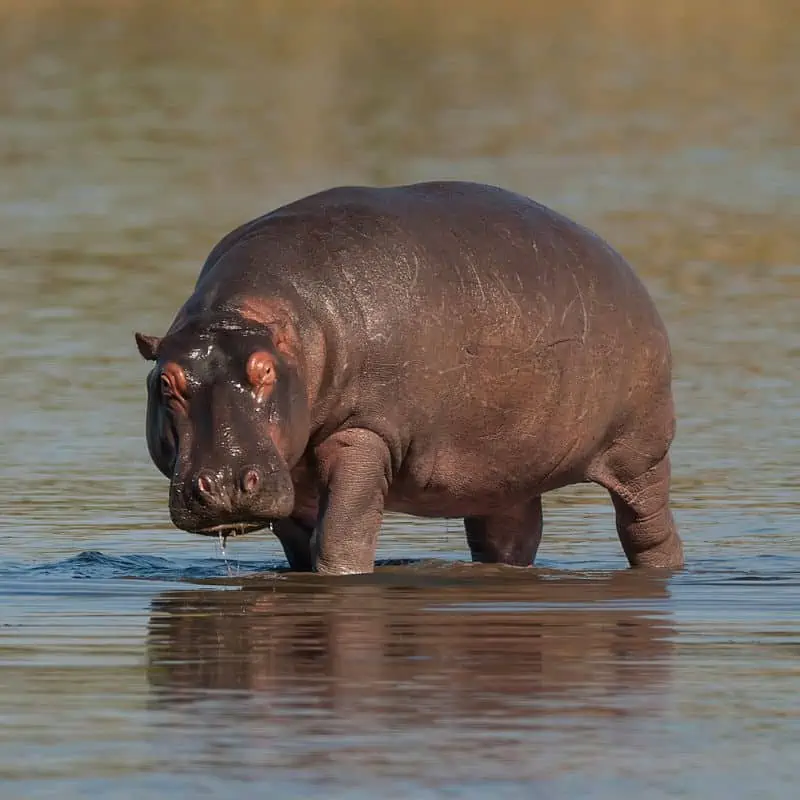Hippos and rhinos are two of the largest land mammals in the world. They’re known for their tremendous size, and many believe they’re quite similar because of this.
However, the two mammals’ physical, habitual, and even behavioral differences are quite far apart.
Let’s take a more thorough look at the hippo vs rhino and what differences and similarities they share.

What Do Hippos and Rhinos Have in Common?
There isn’t much in common between these two magnificent creatures.
There are three main aspects that hippos and rhinos share:
1. Diet
Both hippos and rhinos are herbivores, meaning their diets rely exclusively on plants. Hippos’ main source of nutrition is grass and occasionally fruit. They eat about 88 pounds of grass daily, accounting for about 1.5% of their body weight.
Believe it or not, that is a small portion compared to their weight, as large mammals should consume 2.5% of their body mass daily.
Rhinoceroses follow the 2.5% rule by eating more than 100 pounds of food per day. Since there are five species of rhinos, the food they prefer will vary a bit. For instance, white rhinos favor grasses, while black rhinos prefer eating leaves.
2. Life Expectancy
Rhinos and hippos have pretty close life expectancies. Although each rhino species’ lifespan slightly differs, we can say that their average life expectancy ranges from 35 to 50 years.
Meanwhile, the lifespan of hippos is between 40 and 50 years.
There are always outliers, and the world’s oldest recorded hippo, Lu, recently celebrated his 61st birthday.
3. Threats
Poachers and habitat loss are two of the most serious threats rhinos, and hippopotamuses face.
Poaching
Tragically, hippos are targeted by poachers for their meat and ivory tusks. By the turn of the 21st century, there was a 95% decrease in the number of common hippos in the Democratic Republic of the Congo.
Another troubling statistic revealed in 2002 was the exportation of 5.5 tons of ivory tusks, the equivalent of 2,000 hippos.
Similarly, rhinos are hunted for their horns, which are highly sought after for their supposed medicinal properties, particularly in Asian countries.
According to current estimates, at least one rhino is killed every day.
Habitat Loss
As the human population grows, developments occur at the expense of the natural habitats of hippos and rhinos.
This poses a serious threat to them, whether taking over land or diverting water sources for agriculture.
Lack of land, water, and food sources endangers their lives and even limits their reproductive opportunities.

What Are the Major Differences Between Hippos and Rhinos?
It’s time to learn more about what makes a rhinoceros and a hippopotamus different from one another.
We’ve created a list of six key distinctions:
1. Habitat
Hippos are semi-aquatic animals that spend most of their time in the water. They can stay submerged for up to 16 hours per day. This explains why they were called “hippopotamus” by the Greeks, which means “river horses.”
But here’s the strange part: hippos can’t swim. They simply walk or gallop at the bottom of the water, bouncing up to breathe and then sinking back down.
Hippos spend the majority of their day dipped in freshwater rivers, lakes, and in some cases, estuaries. Then, as the hot sun sets, they begin grazing, and this meal hunt can last up to six hours.
Since rhinos are split between Africa and Asia, they typically occupy various habitats. Some of their primary habitats include:
- Savannas
- Subtropical grasslands
- Deserts
- Tropical moist forests
Most rhino species prefer to stay on dry land; some can drown in deep water. They simply stick to lying in the mud or water puddles to cool off.
However, the greater one-horned rhino adores spending time in the water. Aside from the fact that he likes to swim, he also enjoys diving for food, as he has no problem feeding on aquatic plants.
2. Species and Distribution
The majestic hippopotamus is classified into two species:
- The common hippo (also referred to as the large hippo)
- Pygmy hippo
The pygmy hippopotamus is a much smaller variation of the hippo. It can be spotted in West Africa, specifically Liberia, Guinea, and Cote d’Ivoire.
Whereas East Africa and south of the Sahara are home to common hippos.
In contrast, there are five distinct rhinoceros species:
- Sumatran rhino
- Javan rhino
- Greater one-horned rhino
- Black rhino
- White rhino
The first three species are found exclusively in Asia. The Sumatran rhino is seen in Sumatra and Borneo, the Javan rhino is located in Indonesia, and the Greater one-horned rhino is spotted in India and Nepal.
The last two rhino species live in African countries. Both can be found in Namibia, South Africa, Zimbabwe, and Kenya.
On a side note, despite three species in Asia, Africa has most of the world’s rhino populations.

3. Size
Hippos are ranked as the third-largest land mammals after elephants and rhinoceroses. Remember that this size comparison is held with the largest rhino species, the white rhino.
The size of an adult common hippo is as follows:
- Height (at the shoulder): Up to 5.2 feet tall
- Length: 10 to 16 feet
- Weight: Males, from 3,500 to 9,920 pounds, females up to 3,000 pounds
Moving on to the white rhino, which isn’t actually white. The name is due to this species’ wide lips; early Dutch settlers used to call him “wijde.” This word translates to “wide.”
Because “wijde” sounds like “white,” the English assumed the Dutch were referring to it as “white.” Thus, they began calling this species white rhinos, and the name has stuck.
Now returning to the size of the white rhino, which is as follows:
- Height (at the shoulder): Up to 6 feet tall
- Length: 11 to 15 feet
- Weight: Males, from 3,700 to 5,000 pounds, females up to 4,000 pounds
By the way, the Sumatran rhino, the smallest rhino species, is considered larger than the smallest hippo species, the pygmy hippo.
A Sumatran rhino’s body length can reach eight feet, and its weight can reach 1,760 pounds. Whereas a pygmy hippo has a body length of only six feet and weighs up to 600 pounds.
4. Appearance
By glancing at both, you’d notice the many differences between hippos’ and rhinos’ appearances.
Here are the four main distinctions between the two mammals:
1. Body Shape
A hippopotamus has a massive chunky body supported by thick stumpy legs. The thing is, hippos aren’t fat; their fat layer is extremely thin, which is why they’re easily injured. You can say that most of their weight is attributed to their muscles.
Hippos have huge heads, long muzzles, short necks, and thick skin folds. The standard size of their skulls is 27 inches long, 18 inches wide, and 20 inches tall. This size is nearly equivalent to a fully grown blue heeler dog.
This mammal has four toes, each with tough nails. We can’t call those nails hooves because, unlike most mammals, they don’t cover the entire toe.
Rhinoceros have a more bulky build and a fairly broad chest. They also have stubby necks with a significant hump on them.
All rhinos have relatively large heads and long faces. Moreover, they have three hoofed toes, with the middle one being the largest. Their central toe helps in supporting their body weight.
2. Skin and Color
Hippos have thick skin, particularly on their flanks, which can be two inches thick, though it can be thinner in other areas. Nonetheless, it’s considered sensitive skin and is prone to sunburn.
Their color ranges from purple-gray to brown, with a brownish-pink tint around their eyes and ears. Hippopotamus skin is almost entirely hairless, except for a few hairs around the mouths and tails.
Moreover, hippos’ skin has the unique ability to secrete a sweat-like liquid that acts as a natural sunscreen. This liquid has an oily texture and a red color, which is why it’s known as “blood sweat.” It was long assumed that hippos sweat blood.
Technically, we can’t refer to it as sweat because hippos don’t have sweat glands but secrete this substance through their subdermal glands. Regardless, hippos’ blood sweat effectively absorbs harmful ultraviolet rays and has antibiotic properties.

Rhinos have skin similar to hippos in terms of thickness and sensitivity. However, rhinos’ skin cannot secrete a protective layer.
Alternatively, they beat the heat by rolling in shallow water and mud. When the mud dries on their bodies, it acts as a shield against the hot sun and insects.
Generally speaking, rhinoceroses have grayish-brown skin, though there may be slight variations from one species to another. They’re also hairless except for a small amount of hair on their ears and tails.
3. Mouth
The hippopotamus has the world’s largest mouth among land mammals. When closed, it measures approximately 12 inches from left to right. The impressive part is that it can reach 150 and 180 degrees when it opens.
That said, a hippo only opens his mouth fully in two situations. The first is when it yawns, and the second is when it shows its teeth to ward off threats.
Regarding a hippo’s bite, it’s so vicious that it strikes with a force of around 1,800 psi. It’s classified as one of the deadliest bites in the animal kingdom.
In contrast, the mouths of rhinos are entirely different from those of hippos. However, the structure of a rhino’s mouth is determined by its species and, more specifically, its diet.
White rhinos can smoothly graze on grass thanks to their flat, square upper lip. Whereas a black rhino has a prehensile upper lip that allows him to consume leaves and twigs.
Finally, the three Asian rhino species have somewhat prehensile upper lips and incisors that African rhinos lack.
4. Signatures
Hippos are famed for their immense ivory tusks and teeth. They have tusks on both the upper and lower jaws that can grow 20 inches long. Besides, their front teeth can extend up to 15 inches in length.
A rhinoceros’s signature is undoubtedly his iconic horn. Rhinos typically have two horns, with the front one being larger. Nonetheless, the greater one-horned rhino, also known as the Indian rhino, and the Javan rhino both have a single horn.
The size of the horn differs depending on the species. The longest recorded rhino horn was from a black rhino and measured 51 inches long.

5. Behavior
Hippopotamuses are social mammals that live in groups of 10 to 30. Yet, they’re aggressive, and their fights for leadership and territories can be extremely ferocious.
They also pose a serious threat to humans; they’re considered the world’s deadliest mammal, killing approximately 500 people annually in Africa.
Contrarily, rhinoceroses are much less aggressive than hippos but can still be dangerous around humans. They won’t use their enormous body to fight unless they feel threatened or provoked.
Rhinos prefer to be alone, but a male will leave his solitude for mating, and a female will do the same for her calves. White rhinos are an exception to the rule as they’re more sociable than other rhino species and can live in herds of up to 15.
6. Conservation Status
The hippos’ population is constantly declining due to the threats discussed at the beginning of this article.
The International Union for the Conservation of Nature (IUCN) has listed common hippos as vulnerable. Whereas pygmy hippos are classified as endangered, with only 2,000 to 3,000 individuals remaining in the world.
Sadly, IUCN has labeled all rhino species within the critical range. The Sumatran, black, and Javan rhinos are all critically endangered. The white rhino is classified as near threatened, while the Indian rhino is marked as vulnerable.
To put the magnitude of “critically endangered” into perspective, about 67 Javan rhinos and less than 80 Sumatran rhinos are left worldwide.
Final Thoughts on the Differences Between Rhinos and Hippos
As you can see, although it may seem like these two massive animals share a lot in common, the matter of fact is that they’re a lot more different than they are alike.
Rhinos and hippos can share similar diets and life expectancies and are under similar threats, but that is where their similarities end. They differ in just about every aspect, from their habitat and distribution to their size, appearance, and behavior.
The easiest way to tell these two massive animals apart is to look at their heads; rhinos have a horn, while hippos have massive teeth called tusks.
We hope this article has helped you tell the difference between these two large animals.
